So much for summer! Early July was the coldest in Britain for 20 YEARS, Met Office confirms
Britons had to swap their T-shirts and sunglasses for sweaters and jackets last month as the UK endured its coldest start to July in 20 years.
The Met Office has confirmed that temperatures in the UK were persistently below average for the first two weeks of last month.
And on July 15, the average temperature was 2.0°C below average. This was the coldest start to July since 2004.
In addition, England saw 19 percent more rain than average last month.
“Early July continued the theme of June with cooler than average weather, but also wetter conditions,” explained Met Office scientist Emily Carlisle.
The Met Office has confirmed that temperatures in the UK remained persistently below average for the first two weeks of last month
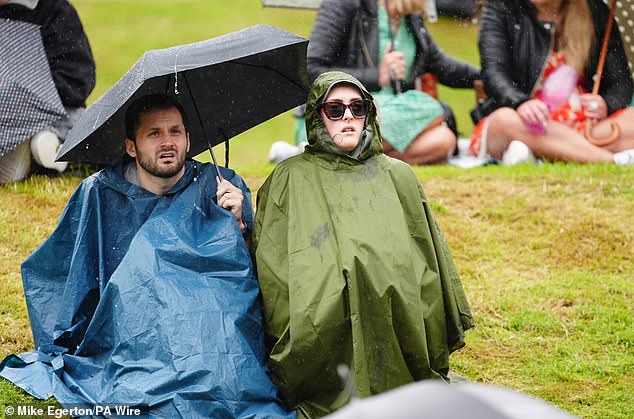
Britons were forced to swap their T-shirts and sunglasses for jumpers and jackets last month as the UK experienced its coldest start to July in 20 years. Pictured: Spectators at Wimbleon on July 9
| Average temperature (°C) | Difference from average (°C) | |
|---|---|---|
| United Kingdom | 14.8 | -0.5 |
| England | 16.0 | -0.4 |
| Wales | 14.6 | -0.7 |
| Scotland | 12.8 | -0.6 |
| Northern Ireland | 14.0 | -0.6 |
Overall, July was cooler than average across the UK, with average temperatures of 14.8°C – 0.5°C lower than the 1991-2020 average.
Although the first two weeks were exceptionally cold, temperatures rose briefly in the third week.
And in the last week of the month, the highest temperature of the year so far was measured.
This was captured on July 30, when people in Kew Gardens and Heathrow enjoyed the sunshine with temperatures reaching 32°C.
It is therefore not surprising that the number of hours of sunshine last month was also below average.
The UK had just 153.7 hours of sunshine per month, 11 percent below average. England, Northern Ireland, Scotland and Wales all missed the average monthly sunshine figure.
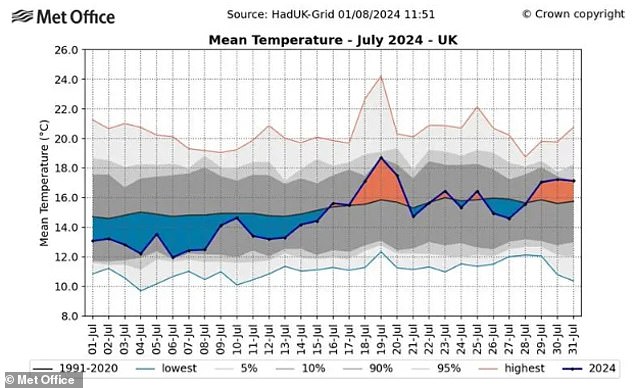
Overall, July was cooler than average across the UK, with average temperatures of 14.8°C – 0.5°C below the 1991-2020 average
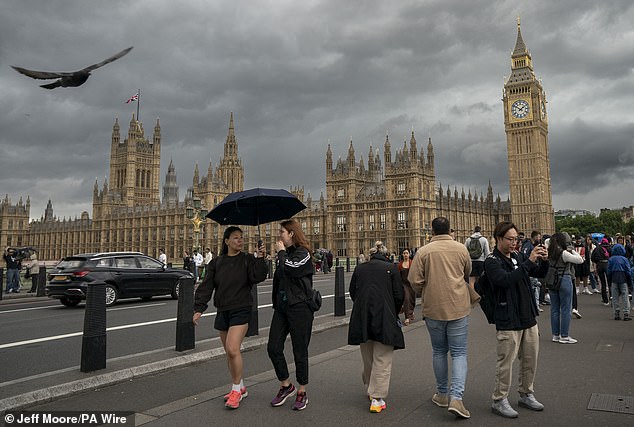
While the first two weeks were particularly cold, temperatures rose briefly in the third week, while the last week of the month saw the highest temperature of the year so far. Pictured: Westminster Bridge on 7 July
The United Kingdom received 82.4mm of rainfall, which is about average.
However, England came out on the losing end, recording 79.0mm of rain, 19 percent above average.
Scotland, Wales and Northern Ireland, on the other hand, were all slightly drier than average.
‘A low pressure area across the UK caused unsettled weather at the start of the month, with several fronts bringing bands of rain,’ Ms Carlisle explained.
‘Areas in the south-west, south-east and north-east of England had already received more rain than the July average on 15 July.’
Unfortunately, things don’t look much better for August.
In its long-term weather forecast (6 August – 15 August), the Met Office predicts ‘changeable’ weather.
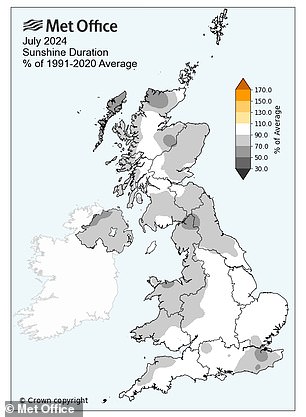

‘Low pressure over the UK caused unsettled weather earlier this month and several fronts brought bands of rain,’ Ms Carlisle explains
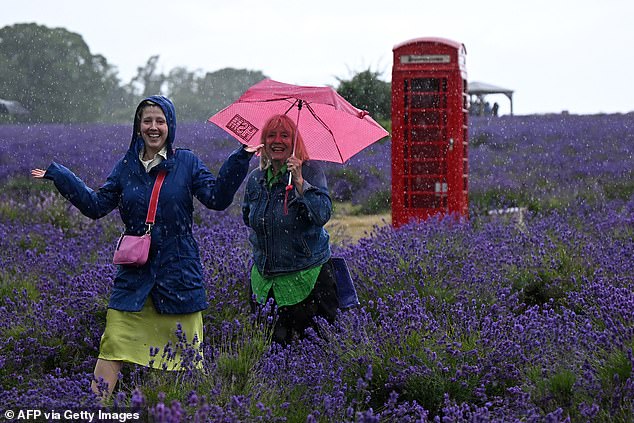
England came out on top, recording 79.0mm of rain – 19 per cent more than average. Pictured: People react to the rain as they visit Mayfield Lavender Farm in Carshalton, southern England on 7 July
‘Much of this period is likely to be changeable, with the weather across the UK characterised by a predominantly westerly type, meaning the weather will be mainly of Atlantic origin,’ the Met Office said.
‘Within this area, the low pressure area is probably further north, which means more frequent rain showers and sometimes windy weather.
‘Conversely, areas further south are more likely to experience higher pressure ridges, bringing more fine, stable weather, although there is still the potential for wetter, stormy or more generally unstable periods.
‘This means that there is occasional chance of warm weather or perhaps even short-lived heat waves in the south, but overall temperatures in the north are likely to be closer to normal.’
